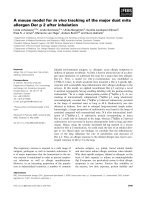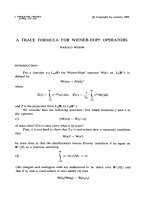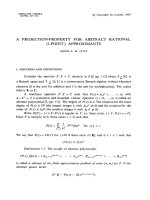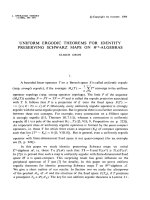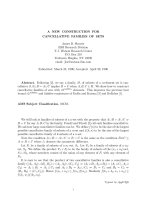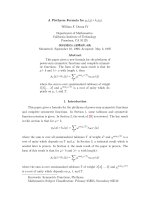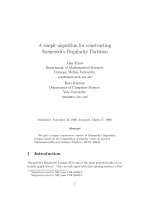Báo cáo toán học: "A Colorful Involution for the Generating Function for Signed Stirling Numbers of the First Kind" pps
Bạn đang xem bản rút gọn của tài liệu. Xem và tải ngay bản đầy đủ của tài liệu tại đây (58.18 KB, 2 trang )
A Colorful Involution for the Generating Function for
Signed Stirling Numbers of the First Kind
Paul Levande
∗
Department of Mathematics
David Rittenhouse Lab.
209 South 33rd Street
Philadelphia, PA 19103-6395
Submitted: Nov 3, 2009; Accepted: Dec 13, 2009; Published: Jan 5, 2010
Mathematics Subject Classification: 05A05, 05A15, 05A19
Abstract
We show how the generating function for signed Stirling numbers of the first
kind can be proved usin g the involution principle and a natural combinatorial in-
terpretation based on cycle-colored permuations.
We seek an involution-based proof of the generating function for signed Stirling numbers
of the first kind, written here as
k
(−1)
k
c(n, k)x
k
= (−1)
n
(x)(x − 1) · · · (x − n + 1)
where c(n, k) is the number of permutations of [n] with k cycles. The standard proof
uses [2] an algebraic manipulation of the generating function for unsigned Stirling numbers
of the first kind.
Fix an unordered x-set A; for example a set of x letters or “colors”. For π ∈ S
n
, let
K
π
be the set of disjoint cycles of π (including any cycles of length one). Let S
n,A
=
{(π, f) : π ∈ S
n
; f : K
π
→ A} be the set of cycle-colored permutations of [n], where f is
interpreted as a “coloring” of the cycles of π using the “colors” o f A. (We follow [1] in
using colored permutations). Further let K
π
(i) be the unique cycle of π containing i f or
any 1 i n, and κ(π) = |K
π
| be the number of cycles of π. Note that
(π,f)∈S
n,A
(−1)
κ(π)
=
π∈S
n
(−1)
κ(π)
x
κ(π)
=
k
(−1)
k
c(n, k)x
k
∗
This research was supported by the University of Pennsylvania Graduate Program in Mathematics
the electronic journal of combinatorics 17 (2010), #N2 1
For (π, f ) ∈ S
n,A
, let R
(π,f)
= {(i, j) : 1 i < j n; f (K
π
(i)) = f(K
π
(j))} be the set of
pairs of distinct elements of [n] in cycles–not necessarily distinct–colored the same way
by f .
Define a map φ on S
n,A
as follows for (π, f ) ∈ S
n,A
: If R
(π,f)
= ∅, let φ((π, f)) = (π, f).
Otherwise, let (i, j) ∈ R
(π,f)
be minimal under the lexicographic ordering of R
(π,f)
. Let
˜π = (i, j) ◦ π, the product of the transposition (i, j) and π in S
n
. Note that, if K
π
(i) =
K
π
(j), left-multiplication by (i, j) splits the cycle K
π
(i) into two cycles; if K
π
(i) = K
π
(j),
left-multiplication by (i, j) concatenates the distinct cycles K
π
(i) and K
π
(j) into a single
cycle. Since f (K
π
(i)) = f (K
π
(j)), define
˜
f : K
˜π
→ A consistently and uniquely by
˜
f(K
˜π
(p)) = f(K
π
(p)) for all 1 p n. Let φ((π, f)) = (˜π,
˜
f).
Note that R
(π,f)
= R
φ((π,f ))
for all (π, f) ∈ S
n,A
, and that therefore φ is involutive.
Note further that, if (π, f) = φ(( π, f )) = (˜π,
˜
f), κ(π) = κ(˜π) ± 1. Note finally that
(π, f) = φ((π, f )) if and only if R
(π,f)
= ∅, or if and o nly if κ(π) = n (so π = e
n
,
the identity permutation of S
n
) and f : K
π
→ A is injective. Therefore |F ix(φ)| =
(x)(x − 1) . . . (x − n + 1). This suffices.
Acknowledgments
The author thanks Herbert Wilf and Janet Beissinger, who was the first to explore [1]
combinatorial proofs using colored permutations, for their assistance.
References
[1] Janet Beissinger. Colorful proofs of generating function identities. Unpublished notes,
1981.
[2] Richard P. Sta nley. Enumerative combinatorics. Vol. 1, volume 49 of Cambridge
Studies in Advanced Mathematics. Cambridge University Press, Cambridge, 1997.
With a foreword by Gian-Carlo Rota, Corrected reprint of the 1986 original.
the electronic journal of combinatorics 17 (2010), #N2 2
